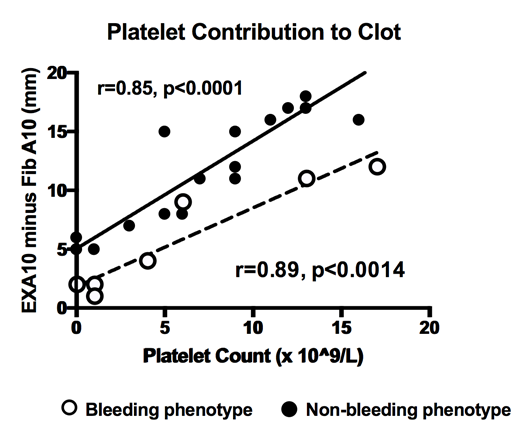Background: Thrombocytopenia occurs reasonably frequently with the underlying causes being numerous and requiring time to delineate. Patients may present with active bleeding or low platelet counts may be detected incidentally. Treatments are varied, refractory cases are not uncommon, and in those who do respond, relapses occur. The clinician's principal concern is to limit the risk of a life-threatening hemorrhage, however, the platelet count is an unreliable predictor of bleeding risk. Adult patients presenting with platelet counts < 20 x 109/L present the greatest safety dilemma for clinicians. Previous studies using ROTEM in adult ITP patients with platelet counts < 60 x 109/L and paediatric cases with platelet counts < 30 x 109/L demonstrated that clot firmness parameters correlated with bleeding score1. Our aim, therefore, was to perform ROTEM analysis on patients with a platelet count <20 x 109/L and correlate with bleeding status.
Methods: Patients referred to the Haematology Department of The Canberra Hospital with thrombocytopenia were consented to the study. Blood was collected into Na-citrate tubes and analysed within 4 hr of collection. Each patient had an EXTEM and FibTEM assay performed on a ROTEM Delta machine. The measurement of fibrinogen levels was commenced part-way through the study. Data was analysed using PRISM software.
Results: Twenty-five blood samples were analysed from 21 patients (17 primary ITP, 2 secondary ITP, 1 AML, 1 sepsis), 7 samples were treatment naive. Platelet count ranged from 0-17 x 109/L (mean 7.1 +/- 5.7) Even in this severely thrombocytopenic cohort, platelet count was a poor predictor of bleeding risk, as was the fibrin clot amplitude measured with FibTEM. In comparison, the calculated value for platelet contribution to clot formation (EXTEM A10 minus FibTEM A10) plotted against the platelet count demonstrated that subjects with a bleeding phenotype had a reduced platelet contribution to clot formation in comparison to their non-bleeding counterparts (Figure).
Conclusions: ROTEM has the capacity to detect platelet dysfunction associated with bleeding in severely thrombocytopenic patients. Further studies are underway to elucidate determinants of platelet dysfunction such as specific anti-glycoprotein antibodies that may inhibit platelet function.
Reference #1: Lindsey A. Greene et al., British Journal of Haematology 166: 592-600 (2014)
D'Rozario:Alexion: Honoraria, Membership on an entity's Board of Directors or advisory committees.
Author notes
Asterisk with author names denotes non-ASH members.


This feature is available to Subscribers Only
Sign In or Create an Account Close Modal